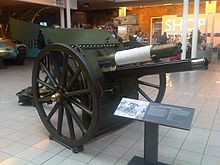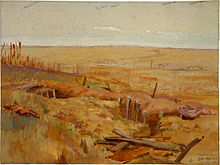3rd North Midland Brigade, Royal Field Artillery
The 3rd North Midland Brigade, Royal Field Artillery was a volunteer unit of the British Territorial Force formed in 1908.
Shortly afterwards, the men were invited to volunteer for overseas service, and the majority having accepted this liability, the North Midland Division concentrated at Luton.
On 19 July the Royal Engineers exploded a mine under the German positions at Hooge, but the infantry of 3rd Division tasked with seizing the crater had not been given a supporting artillery fireplan.
When the Germans attacked the Hooge crater with flamethrowers on 30 July, 139th (Sherwood Foresters) Brigade of 46th Division was able to stabilise the line with the help of the divisional artillery.
The artillery bombardment (by the field guns of 46th and 28th Division, backed by heavy batteries) began at 12.00 on 13 October and the infantry went in at 14.00 behind a gas cloud.
The attack was a disaster, most of the leading waves being cut down by machine gun and shell fire from German positions that had not been suppressed by the bombardment.
Over the first 10 days of the month, the divisional artillery took over the existing battery positions along this front and began digging additional gun pits, observation posts (OPs) and dugouts to new designs.
This group supported the attack of 139th Brigade, which was to be made by two battalions (1/5th and 1/7th (Robin Hoods) Sherwood Foresters) over a frontage of 520 yards into an area of dead ground in front of Gommecourt Wood where the German wire entanglements could not be seen by artillery observers.
The men broke into the first German trench and some parties reached the second, but overall the attack was a bloody failure, as was the whole Gommecourt action.
[43][44][45] CCXXXII Brigade was rested from 5 to 24 May, then joined 19th (Western) Division in IX Corps as it was preparing for the Battle of Messines.
II Corps was preparing for the opening of the Third Ypres Offensive, and CCXXXII AFA Bde was allocated to 8th Division from 30 June.
Batteries also had the task of swinging off to engage targets of opportunity, and had spare detachments to avoid exhaustion of the gunners.
[43][54][55][56][57][58][59] CCXXXII AFA Brigade then switched to 59th (2nd North Midland) Division for the successful Battle of Polygon Wood (26–30 September).
The Commander, Royal Artillery, of the New Zealand Division stated that he could not take part in the attack of 12 October because it was impossible to move the batteries across the Steenbeck, but he was ignored.
[43][57][60][61] The brigade was withdrawn on 21 October before the fighting at Ypres was over, and moved south to join III Corps for the Battle of Cambrai.
[43] Although the battle is famous for the first mass use of tanks, the plan was also notable for employing a massive surprise artillery barrage at zero hour with no preceding bombardment or registration.
The batteries were secretly moved into position in the days before the attack, CCXXXII AFA Bde joining 12th (Eastern) Division on 13 November.
Located in the Couillet Wood valley, XVII Brigade and CCXXXII RFA Bdes assisted 86th Infantry Bde with rapid fire from four batteries, but the other battery positions were menaced by the large numbers of German infantry advancing towards Marcoing after breaking through 20th (Light) Division's positions.
[63][67][68][69][70] The confused fighting continued on 1 December, with the remaining 11 guns of CCXXXIII Bde supporting 29th Division as it swung back to cover the positions on the St Quentin Canal.
The divisional artillery commander withdrew the forward batteries of XVII and CCXXXII Bdes from south of Marcoing half way back to Ribécourt-la-Tour.
[43][82] After a spell in Corps Reserve, the brigade joined 62nd (2nd West Riding) Division for the Battle of Havrincourt on 12 September.
It then switched to the 4th Australian Division for the follow-up attack (the Battle of Épehy), which followed a 'splendid' barrage and made deep inroads into the German positions.
[43][83][84][85] On 22 September 1918 the brigade transferred to IX Corps, which had been reconstituted in Fourth Army to take a leading role in the continuing Hundred Days Offensive.
[91] The first of these creeping barrages actually progressed at twice the normal pace while the infantry rushed downhill to seize the canal crossings; it was described in the Official History as 'one of the finest ever seen'.
[88] The attack was a brilliant success, and by the afternoon the field artillery batteries were crossing the canal by the bridges that had been captured or thrown across, and were coming into action on the far side.
The 6th was troubled by a French formation on the flank not coming up, and a creeping barrage not being fired for a second attack, but still took nearly all the objectives, including 'Mannequin Wood'.
[43][86][93][94][95][96] It was CCXXXII AFA Brigade's last action; from 10 October until the Armistice with Germany it was in GHQ Reserve with Third Army.
[6][18][98] At first the 2nd Line recruits had to parade in civilian clothes and train with 'Quaker' guns – logs of wood mounted on cart wheels – but these shortages were slowly made up.
The divisional artillery were joined at Luton by the 1st Line 4th Home Counties (Howitzer) Brigade, RFA, and Wessex Heavy Bty, RGA, which were fully equipped and could lend guns for training.
[6][26][18][98][42][101] In January 1917, the 59th Division was relieved in Ireland and returned to the UK, concentrating at the Fovant training area on the edge of Salisbury Plain preparatory to embarking for France.






